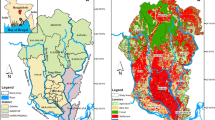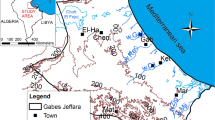Abstract
In order to evaluate groundwater regional resources, a mathematical model of the Gdansk hydrogeological system (Poland) was developed. The research area covers about 2,800 km2. Groundwater occurs in Cretaceous, Paleogene and Neogene formations. The recharge zone is situated in the glacial upland of the Kashubian Lake District. The discharge zone spreads over the lowlands of Gdansk and beneath the Bay of Gdansk (Baltic Sea). The MODFLOW program was used to develop a three-dimensional steady-state model on the basis of data from over 1,700 boreholes. The research area was digitalized as a square network of sides 200 m in length. Simplification of groundwater occurrence allowed four aquifers to be distinguished: upper Pleistocene, Pleistocene-Miocene, Oligocene-Eocene, and Cretaceous and also four intervening aquitards. The mathematical model calculations showed that the system is recharged mainly by precipitation (infiltration recharge is 136 mm/year). The precipitation recharge amounts to 1,045,440 m3/day. The other part of the inflow constitutes lateral flows from beyond the area of research and also to some extent from losing rivers and lakes. The runoff from the system takes place mainly through gaining streams and through lateral outflow including under-sea and lake discharge.
Résumé
Afin d’évaluer les ressources en eau souterraine régionale, un modèle mathématique régional du système aquifère de Gdansk (Pologne) a été développé. La zone d’étude couvre environ 2,800 km2. Les eaux souterraines se trouvent dans les formations du Crétacé, Paléogène et Néogène. La zone de recharge est située sur le plateau glaciaire du district du lac de Kashubian. La décharge se fait dans la basse plaine de Gdansk et jusqu’à la baie de Gdansk (mer Baltique). Le programme MODFLOW a été utilisé pour développer un modèle 3D en régime permanent sur la base des données de quelques 1,700 forages. La zone d’étude a été digitalisée sur un réseau carré de 200 m de côté. Une simplification hydrogéologique permet de distinguer quatre aquifères: le Pléistocène supérieur, le Pléistocène-Miocène, l’Oligocène-Eocène et le Crétacé séparés par autant d’aquitards. Les calculs du modèle mathématique montrent que le système est rechargé principalement par les pluies (infiltration de 136 mm/an). La recharge totale par les précipitations est de 1,045,440 m3/an. L’autre part des apports est constituée par un flux latéral au delà de la zone d’étude et, dans une moindre mesure, par les pertes de rivières et lacs. L’écoulement souterrain se fait essentiellement vers les cours d’eau et par décharge dans la mer et lac.
Resumen
Con el objeto de evaluar los recursos regionales de aguas subterráneas se desarrolló un modelo matemático del sistema hidrogeológico Gdansk. El área de estudio cubre alrededor de 2,800 km2. Las aguas subterráneas se encuentran en formaciones cretácicas, paleógenas y neógenas. La zona de recarga está situada en tierras altas glaciales del distrito del Lago Kashubian. La zona de descarga se extiende sobre las tierras bajas de Gdansk y por debajo de la Bahía de Gdansk (Mar Báltico). Se usó el programa MODFLOW para desarrollar un modelo tridimensional en estado estacionario sobre la base de los datos de 1,700 pozos. El área de estudio fue digitalizada como una red cuadrada de lados de 200 m de longitud. La simplificación de la existencia de aguas subterráneas permitió distinguir cuatro acuíferos: Pleistoceno superior, Pleistoceno-Mioceno, Oligoceno-Eoceno y Cretácico y también la intervención de cuatro acuitardos. Los cálculos del modelo matemático mostraron que el sistema es recargado principalmente por precipitaciones (la recarga por infiltración es 136 mm/año). La recarga por precipitación asciende a 1,045,440 m3/día. Las otras partes del ingreso de agua están constituidas por flujos laterales provenientes de fuera del área de estudio y también en alguna medida a partir de las pérdidas de ríos y lagos. El escurrimiento del sistema de lagos tiene lugar principalmente a través de corrientes ganadoras y por flujos laterales salientes que incluyen a la descarga en lagos y submarina.
摘要
为评价区域地下水资源, 建立了波兰Gdansk水文地质系统的数学模型。研究区面积为2800 km2, 地下水分布在白垩系、古近系和新近系地层。补给区位于Kashubian湖区的冰川高地, 排泄区遍布Gdansk洼地和波罗的海海湾之下。基于1700多个钻孔的数据利用MODFLOW程序建立了一个3D稳定流模型。模型将研究区数字化为一个长200 m的矩形网格, 简化地下水分布, 得到四个含水层 : 上更新统、更新统—中新统、渐新统—始新统和白垩系含水层, 及四个弱透水层。数学模拟结果表明, 地下水系统的主要补给来源是降水, 入渗补给量为136 mm/a, 降水补给量为1,045,440 m3/d。另一补给项是侧向流入和河、湖的渗入, 系统的排泄项包括向河的排泄以及包括向海、湖之下排泄在内的侧向流出量。
Resumo
Com o objectivo de avaliar os recursos regionais de água subterrânea, foi realizado um modelo matemático do sistema hidrogeológico de Gdansk (Polónia). A área de estudo tem cerca de 2,800 km2. A água subterrânea ocorre em formações cretácicas, paleogénicas e neogénicas. A zona de recarga está situada nas terras altas glaciares do Distrito do Lago Kashubian. A zona de descarga está distribuída pelas terras baixas de Gdansk e no fundo da Baía de Gdansk (Mar Báltico). O programa MODFLOW foi usado para criar um modelo 3D, em estado estacionário, baseado nos dados de mais de 1,700 furos. A área de estudo foi digitalizada com uma malha rectangular com elementos de 200 m de lado. A simplificação da ocorrência de água subterrânea permitiu distinguir quatro aquíferos: Plistocénico superior, Plistocénico-Miocénico, Oligocénico-Eocénico e Cretácico, e também quatro aquitardos intervenientes. Os cálculos do modelo matemático mostram que a recarga do sistema provém principalmente da precipitação (a recarga por infiltração é de 136 mm/ano). A recarga devida à precipitação totaliza 1,045,440 m3/dia. A outra parte da recarga é constituída por fluxos laterais a partir de áreas adjacentes à área de estudo e, também, em certa percentagem, por fluxos de rios e lagos influentes. O fluxo de saída do sistema ocorre sobretudo através de linhas de água drenantes e através de fluxo lateral, incluindo descarga submarina e no fundo de lagos.













Similar content being viewed by others
References
Alley WM, Leake SA (2004) The journey from safe yield to sustainability. Ground Water 42(1):12–16
Anderson MP, Woessner W (1992) Applied groundwater modeling: simulation of flow and advective transport. Academic Press, London
Bredehoeft JD (1997) Safe yield and the water-budget myth. Ground Water 35(6):929
Bredehoeft JD (2002) The water budget myth revisited: why hydrogeologists model. Ground Water 40(4):340–345
Burzynski K, Sadurski A (1989) Odplyw podziemny do Balyku w rejonie Gdanska [Groundwater outflow to the Baltic Sea in the Gdansk region]. Politechnika, Gdanska, Gdansk
Dowgiallo J, Kleczkowski AS, Macioszczyk T, Rozkowski A (2002) Slownik Hydrogeologiczny [Hydrogeological dictionary]. Panstwowy Instytut Geologiczny, Warsaw
Galon R (1972) Geomorfologia Polski, Niz Polski [Geomorphology of Poland: Polish lowlands], vol 2. PWN, Warsaw
Gurwin J (2000) Model hydrogeodynamiczny systemu wodonosnego Pradoliny Odry [Groundwater flow model of the Odra ice-marginal valley aquifer system]. Prace Geologiczne-mineralogiczne LXX. Wydawnictwo Uniwersytetu Wroclawskiego, Wroclaw, Poland
Gurwin J, Lubczynski M (2005) Modelling of complex multi-aquifer systems for groundwater resources evaluation: Swidnica study case (Poland). Hydrogeol J 13:627–639
Hydrological Yearbooks (1966–1976) Roczniki Hydrologiczne. Dorzecze Wisly i rzeki przymorza na wschod od Wisly [The river basin of the Vistula and Pomeranian rivers to the east of Vistula]. IMGW, Wydawnictwo Komunikacji i Lacznosci, Warsaw
Jaworska-Szulc B (2004) Examination of the effect of altering model complexity on representing groundwater flow. Pol J Environ Stud 13(5):521–524
Jaworska-Szulc B (2007) Odnowa zasobow gornokredowego pietra wodonosnego w rejonie Gdanska [Groundwater resources regeneration in Cretaceous aquifer, Gdansk region]. Inzynier Morska Geotech 28(1):9–13
Jaworska-Szulc B, Pruszkowska M, Przewlocka M (2005) Groundwater quality regeneration in the discharge zone of the Gdansk aquifer system. In: Hydrogeochemistry ‘05: International symposium New Trends in Hydrogeochemistry. Fl’aková and Zenisova, Bratislava, Slovak Association of Hydrogeology, Bratislava, Slovakia, pp 163–166
Jurys L (2002a) Morfogeneza regionu a zanik ostatniego ladolodu zlodowacenia Wisly na Pojezierzu i Pobrzezu Kaszubskim [The relief and geomorphology of the Kashubian Lake District and the last deglaciation]. Geologia Regionu Gdanskiego, Panstwowy Instytut Geologiczny, Poland
Jurys L (2002b) Poziomy sandrowe w rynnie Radunskiej [Sander sediments in the Radunia glacial valley]. Geologia Regionu Gdanskiego, Panstwowy Instytut Geologiczny, Poland
Kozerski B (1984) Groundwater resources of Gdansk region: groundwater resources utilization and contaminant hydrogeology. International Groundwater Symposium, Montreal, Quebec, May 1984, pp 116–124
Kozerski B (1988) Warunki wystepowania i eksploatacji wod podziemnych w gdanskim systemie wodonosnym [Groundwater occurrence and exploitation in the Gdansk aquifer system]. Wspolczesne Problemy Hydrogeol IV:1–22
Kozerski B, Jaworska-Szulc B, Pruszkowska M, Przewlocka M (2005) Wysladzanie sie wod podziemnych w pietrze czwartorzedowym Gdanska jako rezultat zmniejszonego poboru [The groundwater desalinization in the Quaternary aquifer in Gdansk as a result of decreasing exploitation]. Wspolczesne Problemy Hydrogeol 12:371–375
Lidzbarski M, Kordalski Z (2003) Wystepowanie i dynamika trzeciorzedowego pietra wodonosnego w regionie gdanskim [Dynamic and occurrence of groundwater in the Tertiary aquifer in the Gdansk region]. Wspolczesne Problemy Hydrogeol XI(1):121–128
Makowska A (1986) Morza plejstocenskie w Polsce [Pleistocene seas in Poland]. Pr. Inst. Geol. 120:74, Polish Geological Institute, Warsaw
Marciniak M, Przybylek J, Herzig J, Szczepanska J (1999) Badania wspolczynnika filtracji utworow polprzepuszczalnych [The examination of hydraulic conductivity in semipermeable formations]. Uniwersytet im A. Mickiewicza w Poznaniu, Akademia Gorniczo Hutnicza, Cracow, Poland
Marks L, Ber A, Gogolek W, Piotrowska K (2006) Geological map of Poland. Polish Geological Institute, Warsaw
McDonald MG, Harbaugh AW (1988) A modular three-dimensional finite-difference ground-water flow model. Techniques of Water-Resources Investigations, book 6, chapter A1, US Geological Survey, Reston, VA, 586 pp
Meteorological Yearbooks (1931–1981) Roczniki Meteorologiczne. Panstwowy Instytut Hydrologiczny i Meteorologiczny, Wydawnictwa Komunikacyjne, Warsaw
Michalowska M (2000) Litologia glin zwałowych strefy brzegowej regionu gdanskiego [Lithology of glacial tills in the coastal zone of Gdansk region]. Panstwowy Instytut Geologiczny Posiedzenia Naukowe no. 56(8), Polish Geological Institute of Science, Warsaw
Mizerski W (2005) Geologia Polski [Geology of Poland]. Wydawnictwo Naukowe PWN, Warsaw
Mojski J E (2005) Ziemie Polskie w Czwartorzędzie [Polish land in the Quaternary]. Panstwowy Instytut Geologiczny, Warsaw
Pazdro Z, Kozerski B (1990) Hydrogeologia ogolna [Hydrogeology]. Wydawnictwa Geologiczne, Warsaw
Piekarek-Jankowska H (1979) Wody podziemne dorzecza górnej Raduni i ich znaczenie w zasilaniu jezior rynnowych [Groundwater of the river basin of upper Radunia and its influence on recharge postglacial channel lakes]. In: Aqueous Stores of the Kashubian Lake District and the water supply of the Gdansk urbanized area, Gdansk. Gdansk Learned Society, Gdansk, pp 68–86
Piekarek-Jankowska H (1996) Hydrochemical effects of the submarine groundwater discharge to the Puck Bay. Geographia Polonica (Global Change: Polish Perspectives) 67:103–119
Pleczynski J (1981) Odnawialnosc wod podziemnych [Groundwater renewal]. Wydawnictwa Geologiczne, Warsaw
Pruszkowska M (2004) Hydrochemia wod podziemnych z utworow czwartorzedu Pojezierza Kaszubskiego [Hydrochemistry of Quaternary groundwater in the Kashubian Lake District]. Monograph no. 51, Gdansk University of Technology, Gdansk
Rojas R, Dassargues A (2007) Groundwater flow modeling of the regional aquifer of the Pampa del Tamarugal, northern Chile. Hydrogeol J 15:537–551
Sadurski A (1976), Studium zasobow kredowego pietra wodonosnego w rejonie Gdanska w swietle metod paleohydrogeologicznych [The research on resources of the Upper Cretaceous artesian basin of the Gdansk region]. PhD Thesis, Gdansk University of Technology, Poland
Sadurski A (1984) Zasoby wod podziemnych pietra kredowego w rejonie Trojmiasta [Groundwater resources of Cretaceous aquifer in the Tricity region]. Techn Poszuk Geol 3:28–32
Sadurski A (1986) Hydrogeological evolution of the Upper Cretaceous artesian basin of the Gdansk region. Ann Soc Geol Pol 56:143–161
Stachy J (1987) Atlas Hydrologiczny Polski [Hydrological atlas of Poland]. Instytut Meteorologii i Gospodarki Wodnej, Wydawnictwa Geologiczne, Warsaw
Thiem G (1916) Expertise on water-supply system development in Gdansk, with two sketches and one plan. Gdansk University of Technology, Gdansk, 15 pp
Witczak SL, Prazak J, Zurek A (2002) Wody podziemne i powierzchniowe jako niepodzielny zasob srodowiska wodnego [Groundwater and surface waters as the indivisible store of the aqueous environment]. “Problems of Using Groundwater in Public Utilities”, 14th Conference, Czestochowa, Poland, 19–28 April 2002, pp 19–28
Acknowledgements
The research reported in this paper was supported by the Polish Ministry of Science and Higher Education, under grant KBN 4T12B 06026.
Author information
Authors and Affiliations
Corresponding author
Rights and permissions
About this article
Cite this article
Jaworska-Szulc, B. Groundwater flow modelling of multi-aquifer systems for regional resources evaluation: the Gdansk hydrogeological system, Poland. Hydrogeol J 17, 1521–1542 (2009). https://doi.org/10.1007/s10040-009-0473-8
Received:
Accepted:
Published:
Issue Date:
DOI: https://doi.org/10.1007/s10040-009-0473-8




